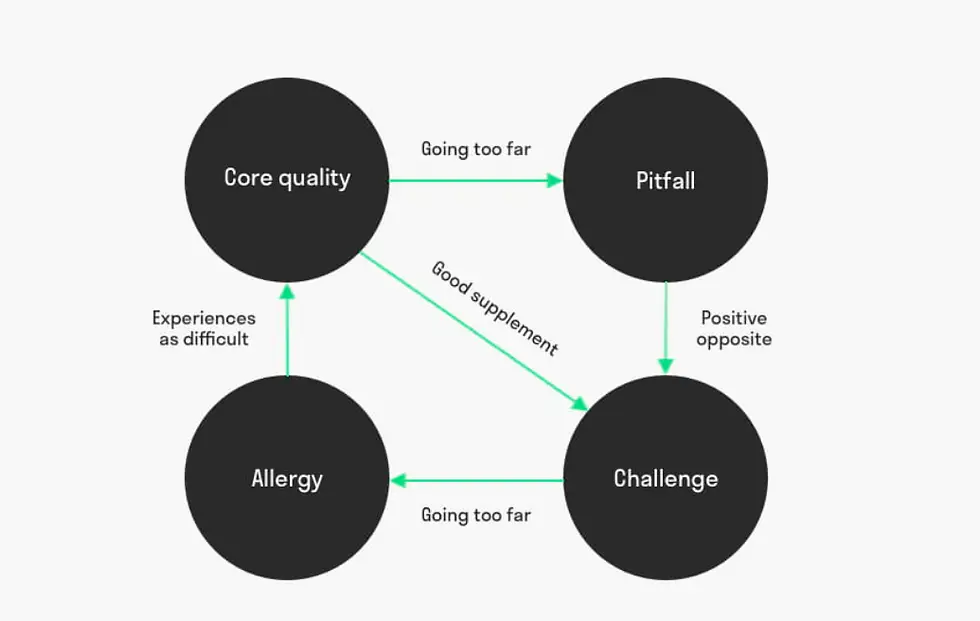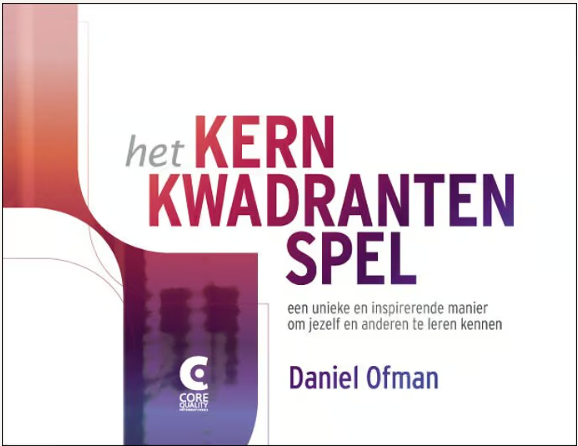Team building with core qualities of Daniel Ofman (incl. Dutch version)

The Core Quadrants by Daniel Ofman are a powerful tool for team development and building. They provide insight into personal and team dynamics by identifying core qualities, pitfalls, challenges, and allergies. Here’s how you can use Ofman’s Core Qualities for team building:
1. Introduce the concept of core qualities
Explanation: Explain the model of core qualities, pitfalls, challenges, and allergies to the team. Use relatable examples, such as:
• Core Quality: Drive
• Pitfall: Acting too hastily
• Challenge: Patience
• Allergy: Passivity
Use visual aids like a diagram or practical examples to make it easy to understand.
2. Identify individual core qualities
Exercise: Ask team members to identify their own core qualities. Use questions like:
• What are you really good at?
• What qualities do others often appreciate about you?
• Encourage team members to reflect on how these core qualities contribute to their work and collaboration.
3. Explore pitfalls, challenges, and allergies
Help each team member explore the possible pitfalls of their core quality by asking:
• What happens when you rely too much on this quality?
• Discover challenges and allergies:
• What can you develop to balance your core quality?
• What traits in others irritate you, and why?
4. Compare and discuss core quadrants within the team
Organize a session where team members share their core quadrants.
Focus on complementarity:
• Which qualities complement each other?
• Where do irritations (allergies) arise, and how can they be resolved?
Reflect: How do different core qualities contribute to team goals?
5. Work on joint team development
Use the core quadrants to address team challenges:
• Are there shared pitfalls within the team (e.g., too much perfectionism)?
• What challenges can help the team grow (e.g., more flexibility)?
• Encourage the team to appreciate each other’s strengths and tackle challenges together.
6. Integrate core quadrants into daily collaboration
- Feedback culture: Encourage team members to give constructive feedback based on the core quadrants.
- Problem-solving: Use core qualities to find solutions and avoid pitfalls.
- Celebrate successes: Highlight how team members’ core qualities have contributed to achievements.
7. Reflection and follow-up
Plan regular evaluations to discuss how the team is utilizing and developing its core qualities.
Show how working with the core quadrants improves team collaboration and performance.
Example in a team:
• Core Quality of Team Member A: Creativity
• Pitfall: Chaotic working style
• Challenge: Adding structure
• Allergy: Rigid rules
• Core Quality of Team Member B: Structured
• Pitfall: Rigidity
• Challenge: Flexibility
• Allergy: Disorganization
These differences might initially cause tensions, but by valuing each other’s qualities, they can learn how their strengths complement and enhance one another.
Would you like a specific exercise or template for a core qualities workshop? Contact me here
Nederlands
1. Introduceer het concept van kernkwaliteiten
De kernkwadranten van Daniel Ofman zijn een krachtig instrument voor teamontwikkeling en teambuilding. Ze bieden inzicht in persoonlijke en teamdynamieken door kernkwaliteiten, valkuilen, uitdagingen en allergieën te identificeren. Hier zijn stappen om de kernkwaliteiten van Ofman in te zetten voor teambuilding:
• Uitleg: Leg het model van kernkwaliteiten, valkuilen, uitdagingen en allergieën uit aan het team. Geef voorbeelden die herkenbaar zijn, zoals:
Kernkwaliteit: gedrevenheid
• Valkuil: overhaast handelen
• Uitdaging: geduld
• Allergie: passiviteit
• Gebruik visuele hulpmiddelen zoals een diagram of praktische voorbeelden om het begrijpelijk te maken.
2. Individuele kernkwaliteiten identificeren
Oefening: Laat teamleden hun eigen kernkwaliteiten benoemen. Gebruik vragen zoals:
• Waar ben je echt goed in?
• Welke eigenschappen waarderen anderen vaak in jou?
• Laat teamleden reflecteren op hoe deze kernkwaliteiten bijdragen aan hun werk en samenwerking.
3. Verken valkuilen, uitdagingen en allergieën
Laat elk teamlid de mogelijke valkuilen van hun kernkwaliteit onderzoeken. Vraag:
• Wat gebeurt er als je te veel leunt op deze kwaliteit?
• Ontdek uitdagingen en allergieën:
• Wat kun je ontwikkelen om je kernkwaliteit in balans te brengen?
• Welke eigenschappen van anderen irriteren je en waarom?
4. Vergelijk en bespreek kernkwadranten binnen het team
Organiseer een sessie waarin teamleden hun kernkwadranten delen.
Focus op complementariteit:
• Welke kwaliteiten vullen elkaar aan?
• Waar ontstaan irritaties (allergieën) en hoe kunnen deze worden opgelost?
Reflecteer: Hoe dragen verschillende kernkwaliteiten bij aan de teamdoelen?
5. Werk aan een gezamenlijke teamontwikkeling
Gebruik de kernkwadranten om teamuitdagingen te adresseren:
- Zijn er gezamenlijke valkuilen in het team (bijvoorbeeld te veel perfectionisme)?
- Welke uitdagingen kunnen het team helpen groeien (bijvoorbeeld meer flexibiliteit)?
- Stimuleer het team om elkaars sterke punten te waarderen en uitdagingen gezamenlijk aan te pakken.
6. Integreer kernkwadranten in dagelijkse samenwerking
- Feedbackcultuur: Moedig teamleden aan om constructieve feedback te geven op basis van kernkwadranten.
- Probleemoplossing: Gebruik kernkwaliteiten om oplossingen te vinden en valkuilen te vermijden.
- Vier successen: Benoem hoe kernkwaliteiten van teamleden hebben bijgedragen aan succes.
7. Reflectie en follow-up
Plan periodieke evaluaties om te bespreken hoe het team de kernkwaliteiten benut en ontwikkelt.
Laat zien hoe het werken met kernkwadranten de samenwerking en prestaties van het team verbetert.
Voorbeeld in een team:
• Kernkwaliteit Teamlid A: Creatief
• Valkuil: Chaotisch werken
• Uitdaging: Structuur aanbrengen
• Allergie: Rigide regels
• Kernkwaliteit Teamlid B: Gestructureerd
• Valkuil: Starheid
• Uitdaging: Flexibiliteit
• Allergie: Ongeorganiseerdheid
Deze verschillen kunnen in eerste instantie spanningen veroorzaken, maar door elkaars kwaliteiten te waarderen, leren ze hoe hun kwaliteiten elkaar kunnen aanvullen en versterken.

Er is een kernkwadranten spel verkrijgbaar in het nederlands. Ik gebruik dit al een aantal jaren met veel succes. Het spel bevat veel kaartjes voor elk kwadrant. Geeft een leuke variatie op bovenstaande teamoefening. Bijv. de kaartjes etaleren en iedereen een kernkwaliteit voor een collega laten uitkiezen en deze met korte toelichting overhandigen. Daarna gezamelijk de kwadranten doorwerken. Geeft hoge kwaliteit feedback naast complimenten.
Wil je ook een specifieke oefening of template voor een kernkwaliteiten-workshop? Contacteer me hier.




